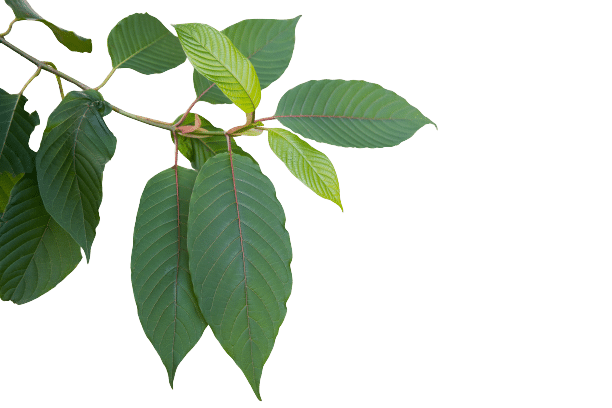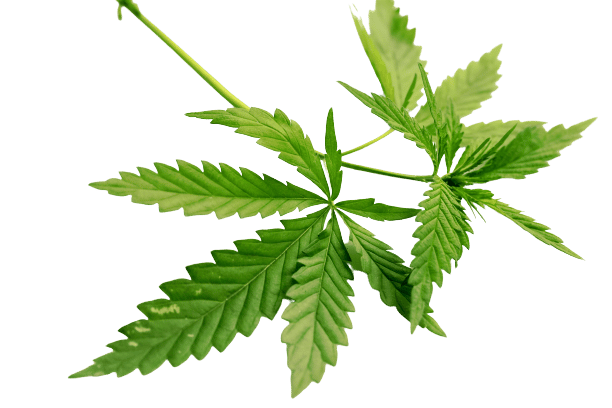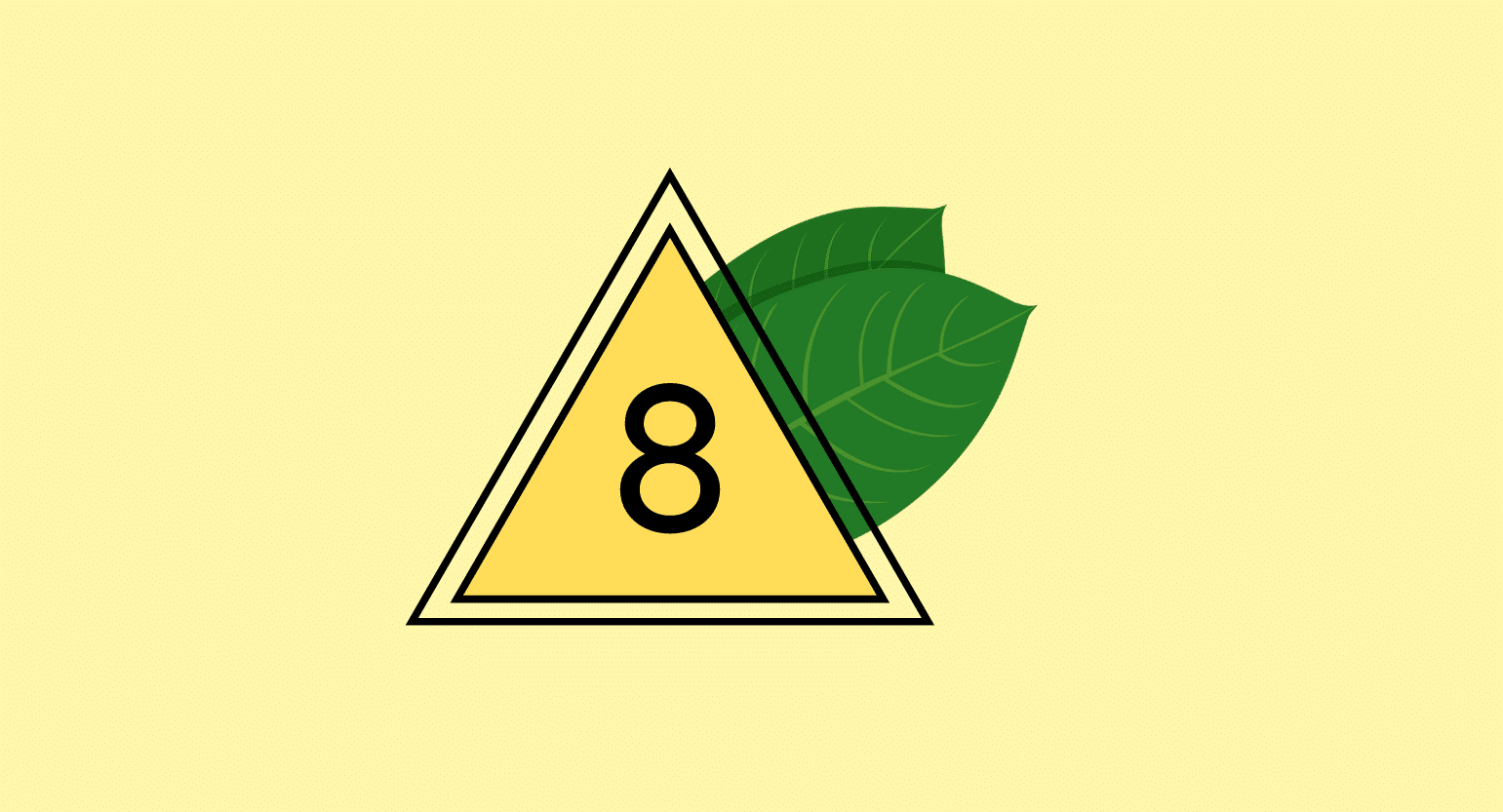What Is Kratom?
Kratom (Mitragyna speciosa) is a naturally-occurring herb in the coffee family with powerfully stimulating and sedating effects. It’s native to Thailand, Indonesia, and other parts of Southeast Asia, where it’s commonly used in traditional medicine.
There are three main strains of kratom. White-vein kratom is stimulating and often used for productivity and focus; red-vein is sedating and usually used to treat pain and insomnia. Green-veins have the effects of a mix of red and white, offering stimulation at lower doses and getting more sedating as the dose increases.
What Is Delta 8 THC?
Delta 8 THC is a cannabinoid found naturally in cannabis plants. It’s related to delta 9 THC (the compound in marijuana that causes the high) and has a similar chemical structure and psychoactive properties, although significantly weaker.
People who find delta 9 THC to be too strong for them often prefer delta 8, saying it’s easier to dose and makes them feel relaxed and euphoric without the unpleasant side effects of delta 9.
Perhaps most importantly, delta 8 THC is considered a legal alternative to marijuana since it’s available in many places where delta 9 THC is not.
Kratom vs. Delta 8 THC
Let’s look at the big picture between kratom and delta 8 THC.
| Kratom | Delta 8 THC | |
| Natural or Synthetic? | Natural | Natural |
| Source | Mitragyna speciosa | Cannabis sativa L. |
| Effects | Energy, euphoria, pain relief, improved mood, relaxed | Creativity, relaxation, mild euphoria, body high |
| Side Effects | Dizziness, mental fog, lethargy, nausea, constipation, diarrhea, anxiety | Paranoia, anxiety, elevated heart rate |
| Uses | Pain, anxiety, depression, insomnia, stress | Mild pain, insomnia |
| Dose | 1-10 g | 10-30 mg |
| Legality | Federally legal in the United States, but banned in the following states: Alabama Arkansas Indiana Rhode Island Vermont Wisconsin | Federally unregulated, with restrictions in the following states: Alaska Arizona Arkansas Colorado Connecticut Delaware Kentucky Idaho Iowa Michigan Mississippi Montana New York North Dakota Rhode Island Utah Vermont Washington |
Kratom vs. Delta 8 THC: Natural or Synthetic?
Kratom and delta 8 THC are both natural substances derived from plants. They are not man-made and, therefore, not synthetic.
The kratom plant is an evergreen tree-like plant related to the coffee family. Its leaves are dried and ground into a fine powder that people use to make capsules or brew tea.
Delta 8 THC comes from cannabis plants, just like delta 9 THC. It is extracted in several ways, often using advanced chemical techniques and complex machinery. Delta 8 is not nearly as abundant in cannabis, nor is it as psychoactive as delta 9, which explains why it was discovered later and is less well-known.
Kratom vs. Delta 8 THC: Effects
Kratom and delta 8 are similar but have several significant differences that make them appeal to different people. In general, delta 8 appeals to people looking for a more intense experience (the high), while kratom attracts people looking for benefits with a clear mind.
Let’s take a closer look at each, one at a time.
Kratom Effects
Kratom’s effect depends mainly on dose and strain.
White strains are usually very stimulating, with many users reporting they feel as energized as drinking several strong cups of coffee. White strains are popular for studying and working since many people feel more they aid their ability to focus and enhance their cognitive abilities.
Green strains are less energizing than white strains but still offer considerable stimulation at lower doses. Fans of green kratom say it provides smoother, cleaner feeling energy and that its effects are roughly split between sedation and stimulation.
Red strains are very sedating, offering only the slightest hint of stimulation at the lowest doses. They’re popular for relaxing, treating pain, and helping people sleep.
The dose also plays a vital role in kratom’s effects. Unlike delta 8, kratom’s effects change character at different amounts. Low doses cause substantial energy boosts while higher doses become increasingly sedating. This unique property of kratom holds across all strains.
Delta 8 THC Effects
Delta 8 THC’s effects are much more straightforward than kratom’s. Think of delta 8 THC as a less potent version of delta 9 THC; this comes close to an accurate picture of delta 8’s effects profile.
Most people say that delta 8 produces a less intense high than delta 9, with similar qualities like mild euphoria, moderate pain relief, and relaxation. Many delta 8 user reports say it feels relaxing without being overly sedating, offering peace of mind without making them fall asleep.
Kratom vs. Delta 8 THC: Side Effects
Kratom and delta 8 THC both have some side effects users need to be aware of, but delta 8’s side effects are much easier to manage.
The most common side effects of kratom are instability, lethargy, confusion, anxiety, nausea, constipation, and diarrhea. These side effects are more likely to occur when taking higher doses, so new users should limit their intake if they’re concerned.
Delta 8 THC’s side effects are more innocuous. Common complaints from taking delta 8 focus on feeling tired or dizzy; less common ones include dry mouth and muscle fatigue.
A critical difference between kratom and delta 8 THC is that kratom can be addicting. Experts recommend controlling your dose of kratom and limiting weekly intake to fewer than five days to decrease the chance of developing a kratom dependency.

Kratom vs. Delta 8 THC: Uses
In general, kratom users are more likely to take it for its analgesic effects, while delta 8 users cite the psychological experience and high as primary reasons for taking it.
Neither has been researched much; most of what we know about delta 8 is due to what we know about delta 9. Like delta 9 THC, there is some evidence that delta 8 may help treat pain and swelling associated with eye damage [1]. Delta 8 has also garnered attention as an appetite suppressant and anti-nausea treatment [2, 3].
Both are used for pain and insomnia, although kratom is said to be significantly better at treating both.
Kratom’s main alkaloids — mitragynine and 7-hydroxymitragynine — provide most of the plant’s benefits. The latter binds to opioid receptors and provides most of kratom’s pain-relieving ability, though both contribute to it [4].
Many people use kratom to reduce anxiety and improve their mood. Studies show kratom can provide these benefits and has a low potential for abuse [5]. This makes it a much better alternative to many prescription medications.
Kratom is also commonly used for energy in small doses. White strains are especially popular among people looking for enhanced concentration and cognitive performance. The energy boost users get from kratom can be pretty substantial, with many saying it’s one to two times stronger than a standard cup of coffee.
Kratom vs. Delta 8 THC: Recommended Dose
A standard dose of delta 8 THC is usually between 10 and 30 mg, depending on the users’ experience with THC, metabolism, and desired effects.
Low doses are better for beginners since they’re less likely to cause side effects. Delta 8 THC is not as potent as delta 9 THC, so experienced users can take significantly larger doses without feeling overwhelmed.
Dosing kratom is more nuanced since its effects depend heavily on how much you take.
Low doses of 1-3 grams are stimulating, giving users a significant energy boost and making them feel alert and focused.
Moderate doses in the 3-6 gram range offer a balance between stimulation and relaxation and are the most popular.
Higher doses of kratom between 6 and 10 grams are best for pain relief and relaxation, although some users find higher doses to be too sedating. A common complaint when taking higher doses is feeling tired and not feeling up to anything besides sleep.

Kratom vs. Delta 8 THC: Legality
Kratom and delta 8 THC are both legal at the federal level in the United States. However, they are not legal in all 50 states.
Some states restrict kratom and delta 8 THC, limiting who can purchase them or banning them outright.
States Where Kratom is Restricted
States Where Delta 8 THC is Restricted
- Alaska
- Arizona
- Arkansas
- Colorado
- Connecticut
- Delaware
- Kentucky
- Idaho
- Iowa
- Michigan
- Mississippi
- Montana
- New York
- North Dakota
- Rhode Island
- Utah
- Vermont
- Washington
Anyone considering kratom or delta 8 THC should familiarize themselves with their local laws.
How Do You Take Kratom & Delta 8 THC?
Kratom and delta 8 THC can both be consumed in various ways.
How to Take Kratom
Most people who take kratom use a powdered form made by grinding up dried kratom leaves. Powdered kratom is usually stirred into water, brewed to make tea, or taken via the “toss and wash” method. The toss and wash method involves filling one’s mouth with water, dumping in kratom powder, and swallowing quickly in one gulp. People use the toss and wash method to avoid the unpleasant bitter taste of kratom powder.
If the bitter taste of kratom powder proves to be too much for you, kratom capsules offer a simpler alternative to using the toss and wash method. Kratom capsules are much more convenient than kratom powder, but they sacrifice dosing flexibility since they come in fixed sizes.
Less common ways to take kratom are in a tincture or liquid extract. Fewer people gravitate towards these methods because they’re more difficult to dose and more expensive.
How to Take Delta 8 THC
Most people take delta 8 THC via vape cartridges, gummies, and tinctures.
Vape cartridges are very portable and easy to use, and the effects are usually felt quickly. Gummies are also very convenient but come in set sizes, so they’re not as good for adjusting dose size as vape cartridges. Gummies also take a lot longer to activate, which can be annoying for some users.
Tinctures are more popular among delta 8 THC users than kratom users but are still less common than gummies and vape carts.

Can You Take Kratom & Delta 8 THC Together?
Although the topic isn’t well studied, kratom and delta 8 THC don’t have any known interactions with each other, so they could be safe to combine.
However, drug interactions are difficult to parse, especially when both drugs in consideration are relatively unstudied. The best bet is to take them separately to avoid potentially unpleasant surprises.
Will Kratom & Delta 8 THC Show Up On a Drug Test?
Kratom won’t show up on a drug test, but delta 8 THC might.
Delta 8 products are legally allowed to contain up to 0.3% delta 9 THC, and most drugs don’t differentiate between the two THCs.
The body processes delta 8 THC the same way it processes delta 9 THC, meaning that delta 8 stays in your body for up to one week or more. The only surefire way to pass a drug test is to avoid taking delta 8 products for one week leading up to the test — or even longer. How long it stays in your body depends on how often you use it.
How to Buy Kratom & Delta 8 THC
Buying kratom and delta 8 THC online is the best way to obtain either substance.
Online kratom and delta 8 vendors have better prices, more variety, and higher-quality products than brick-and-mortar shops. Online vendors reach a wider audience, so they don’t have to worry about wasting shelf space on niche products, allowing them to carry rare strains and less popular items.
Online retailers also benefit from working closely with third-party labs to ensure their products are pure, potent, and safe. Local shops rarely test their products and seldom give customers access to lab reports. Virtually all reputable online kratom and delta 8 shops post the independent lab reports on their websites, so their customers know exactly what they’re getting.
Shipping is the only downside to buying online, although some retailers specialize in fast delivery, closing the gap between online and local wait times. Despite the slightly longer delay with ordering online, the benefits of buying online far outweigh the costs.
Suggested Reading: 10 Best Kratom Vendors Online (2022)

Wrapping Up: Kratom vs. Delta 8 THC
Kratom and delta 8 THC are two of the most available psychoactive substances, and both are becoming more popular every day. At a glance, they appear to have similar effects and uses, but a closer examination reveals several significant differences.
Most users agree that kratom is a more nuanced experience that requires attention to detail and care to use safely and effectively. Between choosing a strain and getting your dose right, using kratom can be daunting for beginners and isn’t good for people interested in recreational use. Kratom’s users are usually more interested in its pain-relieving properties and take it to relax and relieve stress.
Delta 8 THC is much more familiar to most people, and thinking of it as a weaker, legal version of delta 9 THC is not too far off. It’s more popular as a recreational substance, giving users a mild sense of euphoria and relaxation. However, delta 8 THC is also sometimes used to treat pain, insomnia, and anxiety, although more study is needed to determine its clinical viability.
- Thapa, D., Cairns, E. A., Szczesniak, A. M., Toguri, J. T., Caldwell, M. D., & Kelly, M. E. (2018). The cannabinoids Δ8THC, CBD, and HU-308 act via distinct receptors to reduce corneal pain and inflammation. Cannabis and cannabinoid research, 3(1), 11-20.
- Avraham, Y., Ben-Shushan, D., Breuer, A., Zolotarev, O., Okon, A., Fink, N., … & Berry, E. M. (2004). Very low doses of Δ8-THC increase food consumption and alter neurotransmitter levels following weight loss. Pharmacology Biochemistry and Behavior, 77(4), 675-684.
- Abrahamov, A., Abrahamov, A., & Mechoulam, R. (1995). An efficient new cannabinoid antiemetic in pediatric oncology. Life sciences, 56(23-24), 2097-2102.
- Behnood-Rod, A., Chellian, R., Wilson, R., Hiranita, T., Sharma, A., Leon, F., … & Bruijnzeel, A. W. (2020). Evaluation of the rewarding effects of mitragynine and 7‐hydroxymitragynine in an intracranial self-stimulation procedure in male and female rats. Drug and Alcohol Dependence, 215, 108235.
- Swogger, M. T., & Walsh, Z. (2018). Kratom use and mental health: a systematic review. Drug and Alcohol Dependence, 183, 134-140.

